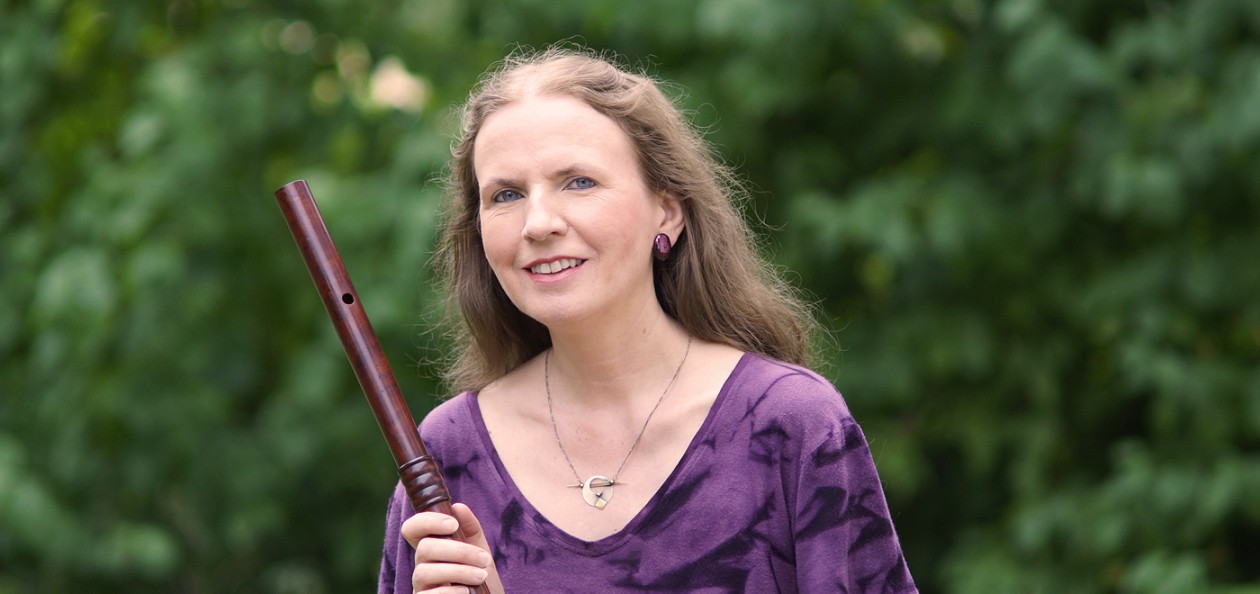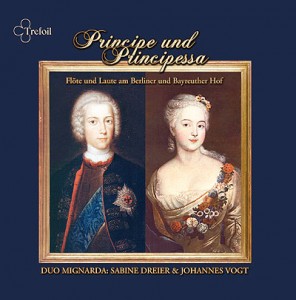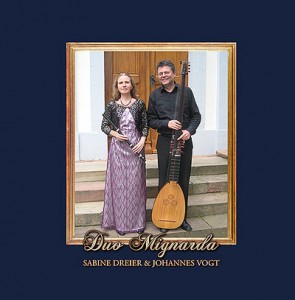PRINCIPE UND PRINCIPESSA
Flöte und Laute am Berliner und Bayreuther Hofe
Sabine Dreier, Traversflöte
Johannes Vogt, Laute
2011
Bemerkungen zum Cover der CD „Principe und Principessa“
„Principe und Principessa“ nannten die Geschwister Wilhelmine und Friedrich ihre Lieblingsinstrumente in Anspielung auf ihre Position als Prinz und Prinzessin. Sie sind vielleicht das älteste bekannte Duo für Laute und Flöte. Wilhelmine wurde zur Markgräfin von Bayreuth und Friedrich zum preußischen König. Nicht zuletzt durch große Musiker wie Kleinknecht und Falckenhagen in Bayreuth oder Quantz und Baron in Berlin kam es dort zu einer kulturellen Blüte. Die beiden Höfe wurden zu Hochburgen der Flöten- und Lautenkunst.
Das Duo Mignarda – Sabine Dreier, Traversflöte und Johannes Vogt, Laute – stellt einige Kompositionen der Zeit vor und lässt die barocke Lebensfreude wieder erklingen.
| Track: | Dauer: | |||
| Jakob Friedrich Kleinknecht | ( 1722 – 1794 ) | Sonata II, E-Moll | ||
| 1 | Largo e con affetto | 2’52 | ||
| 2 | Allegro non molto | 2’37 | ||
| 3 | Presto | 3’09 | ||
| (aus: Sei Sonate da camera, 1748) | ||||
| Paulo Carlo Durant** | ( – nach 1770 ) | Douetto G-Moll | ||
| 4 | Divertimento | 3’14 | ||
| 5 | Allegro | 2’23 | ||
| 6 | Menuet und Trio | 4’03 | ||
| Friedrich der Große | ( 1712 – 1786 ) | Sonate XI, D-Moll | ||
| 7 | Andante | 3’56 | ||
| 8 | Allegro | 4’05 | ||
| 9 | Presto | 2’54 | ||
| Adam Falckenhagen | ( 1697 – 1754 ) | Laute solo: Sonate VI, D-Moll | ||
| 10 | Largo | 2’12 | ||
| 11 | Allegro un poco | 2’06 | ||
| 12 | A tempo giusto | 5’01 | ||
| Wilhelmine von Bayreuth** | ( 1709 – 1758 ) | Sonate A-Moll | ||
| 13 | Affettuoso | 2’00 | ||
| 14 | Presto | 3’14 | ||
| 15 | Allegro | 1’55 | ||
| Johann Joachim Quantz | ( 1697 – 1773 ) | Flöte solo: | ||
| 16 | Fantasie C-Dur | 2’31 | ||
| 17 | Alla francese D-Dur | 1’34 | ||
| (aus: Capricen und Fantasien, 1729) | ||||
| Ernst Gottlieb Baron | ( 1696 – 1760 ) | Sonate G-Dur | ||
| 18 | Allemande | 2’19 | ||
| 19 | Courante | 2’46 | ||
| 20 | Marche | 1’06 | ||
| 21 | Menuett und Trio | 2’32 | ||
| 22 | Loure | 1’21 | ||
| 23 | Gigue | 2’01 | ||
| Carl Philipp Emanuel Bach | ( 1714 – 1788 ) | Sonate D-Dur | ||
| 24 | Andante | 2’36 | ||
| 25 | Allegretto | 2’57 | ||
| 26 | Allegro | 3’49 | ||
Principe and Principessa
Wilhelmine and Friedrich – Lute and Flute, a Historic Duo
In May 1728 the Prussian court in Berlin welcomed the Polish King and Elector of Saxon August the Strong. In his entourage were celebrities of his court orchestra. There is not much preserved about their “wonderful concerts”. One resource of information are the records of the ambassador of Brunswick Wilhelm Stratemann. According to him the musicians stayed several months in Berlin and came again at a later point in time. Johann Joachim Quantz (see below) came on regularly to teach the crown prince Friedrich and sometimes also the heir to the throne of Bayreuth Friedrich, the traverse flute (“Flanto traverse”). These teachings in flute had to be kept secret, for the father, the “soldier King” Friedrich Wilhelm I., did not approve. He did not like these “amusements” and forbade them to his son. The musical life and culture that Friedrich’s mother, the Queen Sophie Dorothea initiated had also to be kept secret.
Friedrich and Wilhelmine were the son and daughter of Prussian King Friedrich Wilhelm I. and Queen Sophie Dorothea. The siblings showed high artistic quality in the concert during the visit of the Polish King August the Strong. Almost all the locations of their appearances, like the Mirror Halll in Berlin and the Palace Monbijou were destroyed during the Second World War.
It is unclear how much the lute playing Wilhelmine profited as a student of the famous lute player Leopold Sylvius Weisss from the court of Dresden. Interesting in this context is a newly published letter from Wilhelmine, dated October 1736. In this letter a certain “Weiss) is mentioned as a member of the orchestra of Bayreuth (see below C.P.E. Bach). It is clear that already in 1728 the tracks were laid for the development of a thriving music culture initiated by Friedrich and Wilhelmine in Bayreuth and Ruppin/Rheinsberg/Berlin. These creative years in their youth were suddenly interrupted in August 1730. The crown prince tried to escape from the fatherly authority, but he was captured and imprisoned. The siblings were separated and isolated from each other. Friedrich waited for his trial in the prison of Kuestrin. Two month later, in October 1730, Friedrich smuggled out a letter of the prison. In this letter Friedrich intensely implores the good times of playing music together with his sister. He courteously switched roles and calls the lute of Wilhelmine “Principe”(the male form) and his flute as “Principessa”(the female form). These unusual Italian names in a letter written in French connect to the political book “Il Principe” by the Italian Niccolo Machiavelli. It is this book that the crown prince later anonymously responded to with his book “Antimachiavell”. He states in his book that the “Principe” (Lord) has to be the servant of the state. The same theme Wilhelmine mentioned already in 1733. She jokingly described her lute, the “Principe”, as the servant to the flute .
Tragedy and Inspiration in the Life of the Pair of Siblings
According to a legend of the time the crown prince fell in love with playing the flute during a boat ride. It was one evening in 1727 on the river Spree close to the Palace Monbijou. Also present was a friend of Friedrich, Hans Hermann von Katte. He was later tried and condemned to death by the father of Friedrich, Friedrich Wilhelm I, But during this evening ride on the water von Katte played the flute and impressed the 16 year ols crown prince so much that he fell in love with the instrument (According to Maria von Katte). This is also supported by over 120 sonatas for flute the crown prince and later King Friedrich the Great (1712-1786) composed during his life. Musicologists gave Friedrich’s work much attention, but his sister Wilhelmine’s musical compositions were only rarely published at the end of the 19.th century or in the middle of the 20.th century. The most recent discovering of the composer Wilhelmine von Bayreuth (1709-1758) is her sonata for flute in a-major (Nikolaus Delius 2002).
Jakob Friedrich Kleinknecht – Star of the Flute Capital Bayreuth
Jacob Friedrich Kleinknecht (1722-1794) was born into a family of musicians in Ulm and arrived in the early 1740s at the orchestra of the court in Bayreuth. He was a talented composer and with him started the climax of Bayreuth as a capital of flute music. Beginning 1748 he published a series of highly valued flute chamber music with the publishing house of lute player Johann Ulrich Haffner in Nuremberg. Already Adam Falkenhagen (see below) was in contact with Haffner. For both composers Johann Wilhelm Stoer engraved the notes and tabulature. Jakob Friedrich Kleinknecht was the younger brother of the first violinist of the orchestra in Bayreuth Johann Wolfgang Kleinknecht. He got the title “Vice-Concertmeister”. Additionaly he received the title “Composer of the Court”, one of the only Bayreuth musicians with this title. His work was published in Paris and London and it was even “pirated”, which testifies to his international acclaim.
Johann Georg Meusel’s writing (“Miszellanteen artistischen Inhalt”) from 1781 describes Wilhelmine’s love for “wild roaring’ flute play. She influenced with this preference the composer Jakob Friedrich Kleinknecht and a style of music called “Sturm und Drang” became popular at the court of Bayreuth.
Paul Charl Durant – Successor of Adam Falckenhagen
Bayreuth was also the caital for playing the lute. Shortly after the death of Falkenhagen in 1754 the lute tradition continued on with the engagement of Paul Charl Durant (1712- ?). Durant’s career started in the boy choir of the cathedral of Pressburg. He was a member of the orchestra in Mannheim until 1746. His expierence in Mannheim could have influenced his new work in Bayreuth. But lute players became increasingly unpopular and were engaged less frequently. After the death of Wilhelmine Durant left Bayreuth. He was last mentioned in 1759 in the court calendar. In the court orchestra of Bayreuth the flute players began to dominate. Four flutes are mentioned in the court calendar. The duet in g-major was original composed for violin and lute and was rearranged for flute and lute (Durant e.g. look R. Thomson-Fuerst, P.Kiraly, J.Domning and F.Legl: The Lute, Yearbook of the German Lute Society, Nr. VII-X, Frankfurt a.M. 2009-2011).
Adam Falckenhagen – Lute Teacher for Wilhelmine
Wilhelmine first learnt to play the piano and in addition learnt to play the lute with her less famous teacher “Feldern”. Through the published letters between Friedrich and Wilhelmine we know that she got more musical training to play the lute beginning 1732 in Bayreuth with the teacher Adam Falckenhagen (1697-1754). She invited him to come to Berlin and even planned to send him to Weiss in Dresden. It is unknwn if this took place.
On a print portrait of Falckenhagn he is playing an instrument which could have been made by Weiss. It is a “theorbierte” lute with 13 strings. This instrument is described by Johann Christoph Gottsched’s encyclopedia from 1760. Falckenhagen dedicated his Opus II. to the Prussian Queen Sophie Dorothea. That can be interpreted as a sign of his connection to the court. He might have played in the Palace Monbijou or was planning to do so. His Opus I. was six sonatas for lute which he dedicated to Wilhelmine in 1736. He thanked her for her professional criticism and for helping him become more familiar with a modern style of music.
Falckenhagen came from Weimar to Bayreuth. His title was soon “Virtuosissimo”, which is the equivalent of a concert master. From 1744 he held the esteemed position as Secretary of Chamber (“Kammersekretaer”) until his death in 1754. Ernestine Charlotte Chretienne Falckenhagen, who might have been his daughter, wrote two tributes for Wilhlmine and her husband Friedrich in 1750. In these published testimonials she mentioned that the court always honored her family.
Falckenhagen died October 6.th 1754 and in the same month Wilhelmine and Friedrich went on a journey to Italy until August 1755. After they returned a music room in the Palace of Bayreuth was decorated. This music room shows how important the relationship between Wilhelmine and Falckenhagen was. On the ceiling of the room is a painting by the court artist Wilhelm Ernst Wunder. It shows Orpheus playing a lyre. The instrument has 13 strings, which is unusual for a lyre, but is equivalent to Falckenhagens 13 stringed lute. In this painting is also a little dog. His name was Folichon and he belonged to Wilhelmine, but died during her journey to Italy. The painting is a memory of him and the court lute player Falckenhagen painted as Orpheus, sitting on a (grave) stone with the little dog by his feet.
Johann Joachim Quantz – Flute Teacher of Friedrich
Johann Joachim Quantz (1697-1773) was taught to play several instruments as a municipal musician in Merseburg. He became court musician in Dresden. From there he traveled regularly to Berlin to teach prince the flute until Friedrich became King in 1740. Quantz moved to the court in Berlin when Friedrich was crowned in 1740 and he was well paid. The same year an unknown correspondent in Berlin wrote about Friedrich’s sister Wilhelmine: “We will soon have the fortune to see here the countesse from Bayreuth. The princess of Oranien has wonderful musical qualities and a special skill in playing the lute.”
Wilhelmine’s husband Friedrich (1711-1763) became count in 1735. He had a good musical education. He was an excellent flute player . His teachers were the same Quantz and Michel Blavet in Paris.
Gottlieb Ernst Baron – Lute Player and Bass Player (“Generalbassspieler”)
In 1732 the crown prince Friedrich started his first small ensemble with the financial help of his mother.It was to be kept a secret. A little later, in 1735, he employed the lute player Gottlieb Ernst Baron (1696-1769).Thus Rheinberg/Berlin became a musical center next to Dresden, Mannheim and Bayreuth. The musicians of Friedrich ensemble liked the plucking of figurine accords of the bass (“Gerneralbass”). This development was a new style of chamber music. This style was different from the orchestra music. Maybe this explains the “vanishing” of Falckenhagen in Bayreuth from the officially published Musical lists of Bayreuth, although he stayed as a member of the chamber staff. There is a collection of lute music in the archives of the city of Augsburg. Composed by the musicians from Bayreuth the collection indicates a “late bloom” of lute music.
Carl Philipp Emanuel Bach – Royal Court Harpsichord Player
It is unclear when the connection between Friedrich the Great and the son of Johann Sebastian Bach, Carl Philipp Emanuel Bach (1714-1788) started. The crown prince Friedrich and his Sister Wilhelmine were a magnet for young musicians who were seeking a career opportunity or were looking for new employment, especially after the death of August the Strong in 1733.
The young violinist Franz Benda of Bohemia visited during his journey from Ruppin to Bayreuth the house of the Bach family in Leipzig. There he met the 20 year old Carl Phhilipp Emanuel. Carl was thinking of leaving Leipzig. It is possible that Benda awakened his interes about the journeys destination and about the Prussian sibling pair Friedrich and Wilhelmine. A newly published letter conforms that Carl Bach had already in 1735 contact to the crown prince Friedrich. (see “Bagatellen aus Berlin”, ed. By G. Berger and J. Wassermann, Berlin 2010). Carl Philipp Emanuel Bach came officially into service after the crowning of Friedrich in 1740.
Antoine Mahaut – a Real Pioneer of the Flute
Wilhelmine’s husband Friedrich had an excellent training in music. He was in Paris a guest of the “concerts spirituels”. Through his influence Bayreuth, a Franconian Caoital, became a center for not only lute playing but also for flute playing. Friedrich became count in 1737 and invited a series of international master musicians. He employed the then very young frendh man Antoine Mahaut (1719-1785) from Namur. Martial Leroux described Mahaut as the “real pioneer” of the flute. (MGG2, supplement 2008). Unexpectly Mahaut was employed as a singer in Bayreuth. In 1735 Mahaut stayed at the court of Bayern. His stay in Franconia could have happened right after that. He had to leave the court in 1737 because of debt, as written in the archives of the treasury (“Markgraefliche Schatulle”).
Irene Hegen
(Translation: Antje Müller)
Duo Mignarda – Curriculum vitae:
The flutist Sabine Dreier was born in Frankfurt am Main. After studies in Frankfurt and Mannheim with leaving examination (=Abschluss) orchestra diploma (Orchestermusik-Diplom) she was awarded the “Premier Prix” (concert examination=Konzertexamen) at the music conservatory in Geneva after studying with Prof. Maxence Larrieu.
She continued her studies in master classes given by Graf, Jaunet, Nicolet, Gilbert, Dick, Kuijken, Brüggen, Hazelzet and others.
In order to utilise the manifold tonal characteristics of her instrument, she plays on many different types of flute from the Middle Ages to modern times. She complements the usual repertoire with new discoveries of excellent composers who have remained unknown.
After playing as solo flutist for the Clara-Schumann-Orchestra in Cologne, the Telemann-Chamberorchestra in Sachsen-Anhalt and in the festival “Internationale Lautentage”, she now concentrates on solo and chamber musical performances at home and abroad which also include radio, CD and television productions. She had particular success with a CD of her own compositions for solo flute. Her premier of the Falckenhagen concertos was among the top ten in Spain in 1996.
Johannes Vogt was born in Bochum, Germany, where he gained his first stage experience as an electric guitarist. He later studied classical guitar and musicology in Heidelberg, followed by a study of the lute and classical guitar with Prof. Tadashi Sasaki in Aachen.
Vogt works both as a teacher and performer, was lecturer for lute and figured bass at the conservatory Heidelberg-Mannheim from 1992-1999 and specialises in ancient music and period instruments:
– Concerts and CD-productions with small groups e.g. the lute-duo “Duo Panormo” (from renaissance to classical), “Between the Times” (lute and saxophon), where he brings together his knowledge of old European melodies and compositions and his experience with improvised music in a new and very personal musical format.
– Playing figured bass in baroque music forms, from chamber orchestra and oratorio to baroque opera, with (among others) the baroque orchestra “L’Arpa Festante”.
Since 2007 the two musicians play together as „Duo Mignarda“.
In September 2011 came out their current CD „Principe und Principessa“ with court music from the 18th century for transverse flute and lute.
Translation: Antje Müller


